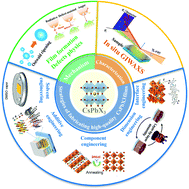Crystallization kinetics modulation and defect suppression of all-inorganic CsPbX3 perovskite films
Abstract
Recently, all-inorganic CsPbX3 perovskite solar cells have stimulated enormous research interest due to their numerous merits including superior thermal and light stability and have become one of the most prominent research domains. In the past decade, the reported power conversion efficiency exhibited a rapid rise increasing from 2.9% to the present 20.8%. This review provides a summary of the recent exciting advancements in film quality optimization engineering and the investigations of the film formation mechanism of CsPbX3 perovskites, aiming to further promote the device performance towards the Shockley–Queisser efficiency limit. We begin with the introduction of the fundamental mechanism analysis of perovskite crystallization kinetics and evaluate the predominant pathways that contribute to non-radiative recombination losses. We subsequently summarize the promising strategies for fabricating high-quality CsPbX3 perovskite films with a particular focus on film formation regulation engineering and defect suppression approaches. Furthermore, we highlight state-of-the-art characterization techniques such as in situ grazing-incidence wide-angle X-ray scattering (GIWAXS) to probe the film formation kinetics to fulfill the purpose of understanding the underlying film formation mechanism. Finally, we provide an outlook on the challenges and opportunities for further promoting the device performance and cover the issues relating to the commercial application of all-inorganic perovskite solar cells in the future.

- This article is part of the themed collection: Energy and Environmental Science Recent Review Articles


 Please wait while we load your content...
Please wait while we load your content...